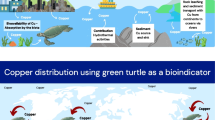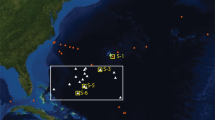Abstract
The planktonic foraminiferal faunal census of core MD 05-2894 (7°2.25′N, 111°33.11′E, water depth 1982 m), retrieved from the southern South China Sea (SCS) during the “Marco Polo” cruise in 2005, was performed to investigate the abundance changes of a subsurface dweller, Pulleniatina obliquiloculata. The results display that the abundance of P. obliquiloculata nearly declines to zero during 16.0-14.9 ka, corresponding to the Heinrich 1 (H1) cold interval. The unexpected decrease of P. obliquiloculata occurs in the adjacent cores, roughly between 17 and 14.8 ka based on the previous studies. Accordingly, the Pulleniatina Minimum Event in the last deglaciation can serve as a good stratigraphical indicator, at least in the southern SCS. To further explore the changes of sea surface temperature (SST) and sub-surface seawater temperature (SSST), we made parallel Mg/Ca measurements on surface dweller Globigerinoides ruber and subsurface dweller P. obliquiloculata tests. Since the last deglaciation, the SSTs show a continuous increasing trend towards the late Holocene, while the warming of the subsurface water is punctuated by a 2°C-cooling interval across the deglacial Pulleniatina Minimum Event. Both increased δ18O differences between G. ruber and P. obliquiloculata, and increased temperature differences between surface and subsurface water suggest a shoaling of the mixed layer during the deglacial Pulleniatina Minimum Event. Therefore, we consider that the significant changes in the upper ocean structure are responsible for the Pulleniatina Minimum Event during the last deglaciation in the southern SCS.
Similar content being viewed by others
References
Bé A W H. An ecological, zoogeographical and taxonomic review of recent planktonic foraminifera. In: Ramsay A T S, ed. Oceanic Micropaleontology. London: Academic Press, 1977. 1–100
Pflaumann U, Jian Z M. Modern distribution patterns of planktonic foraminifera in the South China Sea and western Pacific: a new transfer technique to estimate regional sea-surface temperatures. Mar Geol, 1999, 156:41–83
Thompson P R. Planktonic foraminifera in the western north Pacific during the past 150000 years: comparison of modern and fossil assemblages. Palaeogeogr Paleoclimatol Palaeoecol, 1981, 35:241–279
Chen R H, Jian Z M, Zheng Y L, et al. Seasonal variations of the planktonic foraminiferal flux in the central South China Sea (in Chinese, with English abstract). J Tongji Univ, 2000, 28:73–77
Li B H, Jian Z M, Wang P X. Pulleniatina obliquiloculata as a paleoceanographic indicator in the southern Okinawa Trough during the last 20000 years. Mar Micropaleontol, 1997, 32:59–69
Jian Z M, Wang P X, Saito Y, et al. Holocene variability of the Kuroshio Current in the Okinawa Trough, northwestern Pacific Ocean. Earth Planet Sci Lett, 2000, 184:305–319
Tian J, Wang P X, Chen R H, et al. Quaternary upper ocean thermal gradient variations in the South China Sea: implications for East Asian monsoon climate. Paleoceanography, 2005, 20:PA4007, doi: 10.1029/2004PA001115
Xu J, Holbourn A, Kuhnt W, et al. Changes in the thermocline structure of the Indonesian Outflow during Terminations I and II. Earth Planet Sci Lett, 2008, 273:152–162
Ujiié Y, Ujiié H. Late Quaternary course changes of the Kuroshio Current in the Ryukau Arc region, northwestern Pacific Ocean. Mar Micropaleontol, 1999, 37:23–40
Lin Y S, Wei K Y, Lin I T, et al. The Holocene Pulleniatina Minimum Event revisited: geochemical and faunal evidence from the Okinawa Trough and upper reaches of the Kuroshio Current. Mar Micropaleontol, 2006, 59:153–170
Li T G, Liu Z X, Hall M A, et al. Heinrich event imprints in the Okinawa Trough: evidence from oxygen isotope and planktonic foraminifera. Palaeogeogr Paleoclimatol Palaeoecol, 2001, 176:133–146
Jian Z M, Li B H, Pflaumann U, et al. Late Holocene cooling event in the western Pacific. Sci China Ser D-Earth Sci, 1996, 39:543–550
Peng Y, Xiao J, Nakamura T, et al. Holocene East Asian monsoonal precipitation pattern revealed by grain-size distribution of core sediments of Daihai Lake in Inner Mongolia of north-central China. Earth Planet Sci Lett, 2005, 233:467–479
Wang Y J, Cheng H, Edwards L R, et al. The Holocene Asian monsoon: links to solar changes and north Atlantic climate. Science, 2005, 308:854–857
Jian Z M, Wang B S, Qiao P J. Late Quaternary changes of sea surface temperature in the southern South China Sea and their comparison with the paleoclimatic records of polar ice cores (in Chinese with English abstract). Quat Sci, 2008, 3:391–398
Fairbanks R G, Mortlock R A, Chiu T C, et al. Radiocarbon calibration curve spanning 0 to 50,000 years B.P. based on paired 230Th/234U/238U and 14C dates on pristine corals. Quat Sci Rev, 2005, 24:1781–1796
Wang L J, Sarnthein M, Erlenkeuser H, et al. East Asian monsoon climate during the Late Pleistocene: high-resolution sediment records from the South China Sea. Mar Geol, 1999, 156:245–284
Fang D Y, Cheng X R, Wu G X, et al. Paleoceanographic record of the past 30 ka in the southern Nansha Area, South China Sea (in Chinese with English abstract). Mar Geol Quat Geol, 2000, 20(4):81–86
Huang C Y, Chen M T, Lee M Y, et al. Planktic foraminifer faunal sea surface temperature records of the past two glacial terminations in the South China Sea near Wanan Shallow (IMAGES core MD972151). Western Pacific Earth Sci, 2002, 2:1–14
Ujiié Y, Ujiié H, Taira A, et al. Spatial and temporal variability of surface water in the Kuroshio source region, Pacific Ocean, over the past 21000 years: evidence from planktonic foraminifera. Mar Micropaleontol, 2003, 49:335–364
Sun Y B, Oppo D W, Xiang R, et al. Last deglaciation in the Okinawa Trough: subtropical northwest Pacific link to Northern Hemisphere and tropical climate. Paleoceanography, 2005, 20:PA4005, doi:10.1029/2004PA001061
Steinke S, Chiu H, Yu P, et al. On the influence of sea level and monsoon climate on the southern South China Sea fresh water budget over the last 22,000 years. Quat Sci Rev, 2006, 1477–1488
Steinke S, Yu P, Kucera M, et al. No-analog planktonic foraminiferal faunas in the glacial southern South China Sea: implications for the magnitude of glacial cooling in the western Pacific warm pool. Mar Micropaleontol, 2008, 66:71–90
Moy C M, Seltzer G O, Rodbell D T, et al. Variability of El Nino/Southern Oscillation activity at millennial timescales during the Holocene epoch. Nature, 2002, 420:162–165
Dekens P, Lea D, Pak D, et al. Core top calibration of Mg/Ca in tropical foraminifera: refining paleotemperature estimation. Geochem Geophys Geosyst, 2002, 3:1022, doi:10.1029/2001GC00 0200
Lea D W, Pak D, Spero H. Climate impact of Late Quaternary Equatorial Pacific sea surface temperature variations. Science, 2000, 289:1719–1724
Huang K F, You C F, Lin H L, et al. In situ calibration of Mg/Ca ratio in planktonic foraminiferal shell using time series sediment trap: a case study of intense dissolution artifact in the South China Sea. Geochem Geophys Geosyst, 2008, 9:doi:10.1029/2007 GC001660
Levitus S, Boyer T P. World Ocean Atlas 1994: Temperature. NOAA Atlas NESDIS, Vol. 4. Washington D C U.S. Department of Commerce, 1994
Anand P, Elderfiled H, Conte M. Calibration of Mg/Ca thermometry in planktonic foraminifera from a sediment trap time series. Paleoceanography, 2003, 18:1050, doi:10.1029/2002PA 00846
Zhao M X, Huang C Y, Wang C C, et al. A millennial-scale U k 37′ sea-surface temperature record from the southern South China Sea (8‡N) over the last 150kar: monsoon and sea-level influence. Palaeogeogr Paleoclimatol Palaeoecol, 2006, 236:39–55
Li B H, Jian Z M, Huang B Q, et al. Sea surface temperature estimate and subsurface water evolution in the southern South China Sea (in Chinese with English abstract). J Micropaleontol, 2004, 21:37–43
Jian Z, Huang B, Lin H, et al. Late Quaternary upwelling intensity and East Asian monsoon forcing in the South China Sea. Quat Res, 2001, 55:363–370
Koutavas A, Stieglitz J, Marchitto T, et al. El-Nino-Like Pattern in Ice Age Tropical Pacific Sea Surface Temperature. Science, 2002, 297:226–230
Sarnthein M, Thorsten K, Grootes P, et al. Warmings in the far northwestern Pacific premoted pre- Clovis immigration to America during Heinrich Event 1. Geology, 2006, 34:141–144, doi:10.1130/G 22200.1
Wang D X, Du Y, Shi P. Evidence for thermocline ventilation in the South China Sea in winter. Chinese Sci Bull, 2001, 46:774–778
Author information
Authors and Affiliations
Corresponding author
Additional information
Supported by National Basic Research Program of China (Grant No.2007CB815900), National Natural Science Foundation of China (Grant No. 40621063) and China Ocean Mineral Resources Research and Development Association (Grant No. DY 115-01-2-3)
About this article
Cite this article
An, Y., Jian, Z. Pulleniatina Minimum Event during the last deglaciation in the southern South China Sea. Chin. Sci. Bull. 54, 4514–4519 (2009). https://doi.org/10.1007/s11434-009-0290-4
Received:
Accepted:
Published:
Issue Date:
DOI: https://doi.org/10.1007/s11434-009-0290-4




